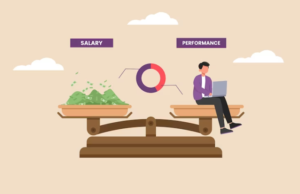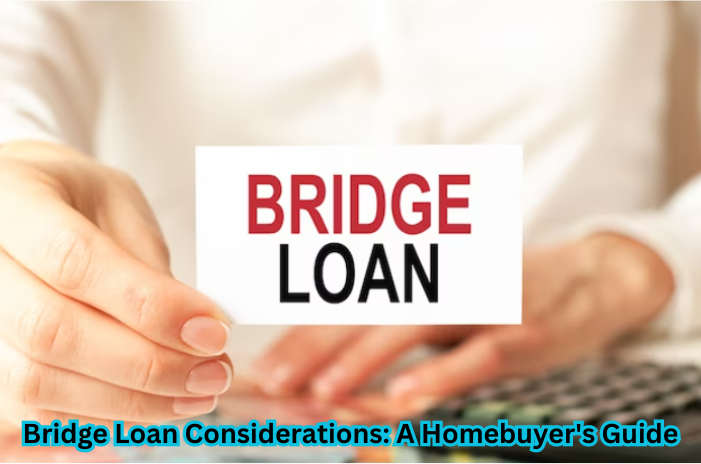Bridge Loan Considerations: A Homebuyer’s Guide
For many people, navigating the maze of financial possibilities is an integral part of buying a home, a monumental life achievement. The bridge loan is one choice that is becoming more common. To assist you in making a well-informed choice regarding this financial instrument, we will explore the details of bridge loans in this tutorial.

“Dive into the insights of Bridge Loan Considerations with our illuminating Homebuyer’s Guide image.”
Understanding Bridge Loans
What is a Bridge Loan?
Simply put, a bridge loan is a financial tool that helps homeowners move from one house to another. This type of loan aims to bridge the gap between selling the present house and purchasing a new one. The period of the loan is typically six months to a year.
When to Consider a Bridge Loan
Timing the Transition
A bridge loan may be a good option if you plan to purchase a new house but can’t wait to sell your old one. You may get the money you need to buy your ideal house without having to wait for the sale of your current property if you take out a bridge loan.
Market Dynamics
Desirable homes move rapidly in a competitive real estate market, so the ability to respond swiftly is vital. With a bridge loan, you may purchase a new house without selling your old one first, making you a more appealing buyer.
Pros and Cons of Bridge Loans
Advantages
Quick Access to Funds
The quick availability of financing is a major perk of bridge loans. When time is of the essence in a real estate market, a bridge loan may be obtained in a matter of days rather than weeks, allowing for more agility.
Flexibility
Thanks to the flexible repayment options offered by bridge loans, you may pay back the loan when your current house sells. If the time it takes to sell your present house is longer than anticipated, this flexibility will be especially helpful.
Disadvantages
Higher Interest Rates
A bridge loan may be convenient, but it comes with a price: higher interest rates. Interest rates on bridge loans are often higher than on conventional mortgages because of the short duration of the loans. When considering the total monetary effect, it is crucial to account for these expenses.
Financial Risk
You can pay two mortgages if your house doesn’t sell in the expected period. You should carefully evaluate your capacity to handle both loan payments in light of this financial risk.
Assessing Your Eligibility
Credit Score Considerations
Checking your credit score is an important first step before applying for a bridge loan. Even while bridge loans are less stringent than conventional mortgages, a good credit score might help you get better conditions.
Equity in Your Current Home
When deciding whether to grant you a bridge loan, many lenders look at the equity you have in your present house. Your chances of getting a bridge loan improve as your equity rises. For this purpose, it is critical to determine the current market worth of your house and the amount of your mortgage.
Navigating the Application Process
Choosing the Right Lender
Getting a bridge loan requires careful consideration when choosing a lender. Please do your homework on several lenders, look at their interest rates, and read the fine print. A lender with expertise in bridging loans may greatly simplify the procedure.
Understanding Loan Terms
Ensure you fully grasp all the repayment terms, fees, interest rates, and circumstances associated with the bridge loan. You can make educated selections when you and your lender agree about the financial commitment.
Mitigating Risks and Planning Ahead
Have a Contingency Plan
You should be prepared to wait if the sale of your current house takes longer than expected, even if bridge loans provide some leeway. Finding a short-term rental or extending the loan terms might be part of this process.

“Navigating the complexities of Bridge Loan Considerations – Your comprehensive Homebuyer’s Guide.”
Financial Planning
A bridge loan should only be considered after extensive budgeting. Consider how this may affect your income, outgoings, and financial situation. Possible difficulties can be lessened by being aware of the dangers and establishing a solid financial strategy.
In summary
Careful use of a bridge loan may make it an invaluable tool in the complicated homebuying landscape. To make a smart choice, you need to know all the factors, good and bad. Before you start purchasing a home, make sure you’re financially prepared, consider the pros and cons, and remember that a smooth transition is the key to a happy homeownership.
FAQ
If you are a first-time purchaser, you have found the definitive resource for understanding the complex world of bridge loans. Those house hunting have probably come across the word, but are you familiar with its nuances? Rest assured, our frequently asked questions (FAQ) guide is here to help you navigate the ins and outs of bridge loans so you can feel more confident in your home-buying journey.
What are the characteristics of a bridge loan?
A bridge loan has several distinctive features.
- Temporal Nature: Bridge loans are intended to be temporary financial solutions; their average tenure is one year or six months.
- Fast Funds Access: One of the primary benefits is the ability for borrowers to move quickly in real estate markets that are always changing.
- Increased Interest Rates: Because bridge loans are riskier and have shorter terms than conventional mortgages, they frequently have higher interest rates.
- Flexible Terms of Repayment: These loans allow borrowers to repay the debt after selling their current home since they provide flexible repayment terms.
What are the problems with bridge loans?
Although bridge loans provide several benefits, they may also present certain difficulties:
- Increased Interest Costs: Bridge loans often have higher interest rates because of their short duration, which raises the total cost of borrowing.
- Financial Risks: You may have to pay two mortgage payments simultaneously if your present house doesn’t sell in the expected amount of time.
- Restricted Eligibility: Bridge loans may have more stringent requirements for qualifying, such as a high credit score and a sizable equity in your existing residence.
What is the meaning of a bridging loan?
A bridging loan, often referred to as a bridge loan, is a short-term financing choice that aids in filling the space left by selling an existing property and acquiring a new one. It ensures that purchasers may move on with purchasing a new house without having to wait for the sale of their present property by acting as a financial bridge throughout the transitional period.
What are the risks of bridge financing?
There are hazards associated with funding bridges.
- Market Volatility: Variations in the real estate market may affect how quickly your current home sells, which may impact your capacity to pay back the bridge loan.
- Interest Rate Volatility: Variations in interest rates may impact the bridge loan’s total cost, which might result in larger payback obligations.
- Unanticipated Circumstances: Because life is unpredictable, unforeseen circumstances like job loss or health problems may make it more difficult for you to make bridge loan installments.
What are the five factors to consider when designing a bridge?
When designing a bridge loan, several things must be carefully taken into account:
- Loan Amount: Ascertain the sum required to close the money gap between acquiring and selling real estate.
- Interest Rates: To get the best conditions, look into and contrast interest rates offered by various lenders.
- Payback Schedule: Considering the probable timetable for selling your current property, create a precise and practical payback schedule.
- Lender Reputation: To guarantee a seamless and open transaction, select a respectable lender with expertise in issuing bridge loans.
- Departure Strategy: Have a well-planned departure strategy with backup plans in place in case the sale of your existing home takes longer than intended.
What are the key features of a loan?
Important characteristics of loans, particularly bridge loans, include:
- Principal: The borrowed amount, including interest, must be paid back.
- Interest rate: The percentage that represents the cost of borrowing and affects the total amount repaid.
- Repayment Terms: The time and schedule decided upon for loan repayment.
- Collateral: Things pledged as security for a loan, such as real estate.
- Terms & Conditions: The particular guidelines that apply to the lending arrangement and any costs or penalties.
You may confidently navigate the world of bridge loans and make decisions relevant to your home buyer requirements by being aware of these basic concepts.




Post Comment